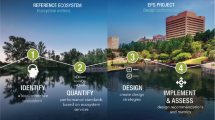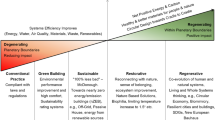Abstract
Design has great potential in city transformations for human well-being and balanced ecological systems. The urban ecosystem services approach is a benchmark for the highest levels of ecological performance, and the Living Building Challenge is the most demanding architecture certification system. Indeed, these approaches may be a way to integrate ecological processes in cities through regenerative design. Therefore, this chapter aims to quantify environmental strategies and define metrics and indicators to achieve the regenerative pattern for transforming cities. A literature review has been made to identify the state of the art of the urban ecosystem services indicators. In the meantime, the requirements of the Living Building Challenge 4.0 for architectural design were considered. Thereby, an analysis has been made to assess the Living Building Challenge criteria in relation to the urban ecosystem services indicators. The two approaches were correlated in order to identify the urban ecosystem services that are addressed by the Living Building Challenge and how they are quantified. From the synergies among these approaches, eight urban ecosystem services categories were created as a design framework. The proposed framework may support and facilitate the design process as it reduces the number of variables without diminishing the requirements for the provision of ecosystem services. The analysis reveals that both approaches can facilitate the implementation of actions aimed at regenerative design when considered together. The environmental metrics and indicators defined for regenerative projects propose a solution to quantify strategies to improve the human-nature relation in cities.
Similar content being viewed by others
References
Albrecht CF (2018) A systemic approach for integrative design of buildings and landscapes: towards ecosystem services provision in urban areas. PhD Dissertation in Architecture, Penn State University
Balmori D, Sanders J (2011) Groundwork: between landscape and architecture. The Monacelli Press, New York
Boyd J, Banzhaf S (2007) What are ecosystem services? The need for standardized environmental accounting units. Ecol Econ 63:616–626
Cortinovis C, Geneletti D (2019) A framework to explore the effects of urban planning decisions on regulating ecosystem services in cities. Ecosyst Serv 38:100946
Costanza R, de Groot R, Braat L, Kubiszewski I, Fioramonti L et al (2017) Twenty years of ecosystem services: how far have we come and how far do we still need to go? Ecosyst Serv 28:1–16
Dobbs C, Escobedo FJ, Clerici N, de la Barrera F, Eleuterio AA et al (2019) Urban ecosystem services in Latin America: mismatch between global concepts and regional realities? Urban Ecosyst 22(1):173–187
Elmqvist T, Setälä H, Handel S, van der Ploeg S, Aronson J et al (2015) Benefits of restoring ecosystem services in urban areas. Curr Opin Environ Sustain 14:101–108
Elmqvist T, Andersson E, Frantzeskaki N, McPhearson T, Olsson P et al (2019) Sustainability and resilience for transformation in the urban century. Nat Sustain 2(4):267–273
Gómez-Baggethun E, Gren Å, Barton DN, Langemeyer J, McPhearson et al (2013) Urban ecosystem services. In: Elmqvist T, Fragkias M, Goodness J, Güneralp B, Marcotullio PJ et al (eds) Urbanization, biodiversity and ecosystem services: challenges and opportunities: a global assessment. Springer, Dordrecht, pp 175–251
International Living Future Institute (ILFI) (2019) Living building challenge 4.0: a visionary path to a regenerative future. International Living Future Institute, Seattle
Kabisch N, Haase D, Elmqvist T, McPhearson T (2018) Cities matter: workspaces in ecosystem-service assessments with decision-support tools in the context of urban systems. Bioscience 68(3):164–166
Landscape Architecture Foundation (LAF) (2018) Evaluating landscape performance: a guidebook for metrics and methods selection. In: Canfield J, Yang B, Whitlow H et al (Orgs) Landscape performance series
Lovell ST, Taylor JR (2013) Supplying urban ecosystem services through multifunctional green infrastructure in the United States. Landsc Ecol 28(8):1447–1463
MA (Millennium Ecosystem Assessment) (2005) Ecosystems and human well-being: synthesis. Island Press, Washington, DC
McDonald RI, Marcotullio PJ, Güneralp B (2013) Urbanization and global trends in biodiversity and ecosystem services. In: Elmqvist T, Fragkias M, Goodness J, Güneralp B, Marcotullio PJ et al (eds) Urbanization, biodiversity and ecosystem services: challenges and opportunities: a global assessment. Springer, Dordrecht, pp 31–52
McPhearson T, Andersson E, Elmqvist T, Frantzeskaki N (2015) Resilience of and through urban ecosystem services. Ecosyst Serv 12:152–156
Meyers M (2013) Multivalent landscape: the Salvation Army Kroc Community Center case study. Landsc J 32(2):183–198
Miller GT, Spoolman S (2009) Living in the environment. Brooks/Cole, Belmont
Mooney P (2014) A systematic approach to incorporating multiple ecosystem services in landscape planning and design. Landsc J 33(2):141–171
Sukhdev P (2013) Foreword. In: Elmqvist T, Fragkias M, Goodness J, Güneralp B, Marcotullio PJ et al (eds) Urbanization, biodiversity and ecosystem services: challenges and opportunities: a global assessment. Springer, Dordrecht, pp v–vii
Tan PY, Zhang J, Masoudi M, Alemu JB, Edwards PJ et al (2020) A conceptual framework to untangle the concept of urban ecosystem services. Landsc Urban Plan 200:103837
The Economics of Ecosystems and Biodiversity (TEEB) (2010) The economics of ecosystems and biodiversity ecological and economic foundations. In: Kumar P. Earthscan, London/Washington, DC
Acknowledgments
We gratefully acknowledge the funding from PIBIC 2020-2021 sponsored by CNPq and the support from the Centro de Ciências Exatas and the Departamento de Arquitetura e Urbanismo (DAU) at the Universidade Federal de Viçosa.
Author information
Authors and Affiliations
Corresponding author
Editor information
Editors and Affiliations
Rights and permissions
Copyright information
© 2022 Springer Nature Switzerland AG
About this entry
Cite this entry
Monteiro, C.B., Albrecht, C.F. (2022). Relating the Metrics and Indicators of the Living Building Challenge and Urban Ecosystem Services for Regenerative Design. In: Leal Filho, W., Azul, A.M., Doni, F., Salvia, A.L. (eds) Handbook of Sustainability Science in the Future. Springer, Cham. https://doi.org/10.1007/978-3-030-68074-9_84-1
Download citation
DOI: https://doi.org/10.1007/978-3-030-68074-9_84-1
Received:
Accepted:
Published:
Publisher Name: Springer, Cham
Print ISBN: 978-3-030-68074-9
Online ISBN: 978-3-030-68074-9
eBook Packages: Springer Reference Earth and Environm. ScienceReference Module Physical and Materials ScienceReference Module Earth and Environmental Sciences




